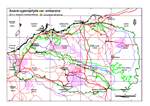Click on images
to enlarge



Photographer: B.R. Maslin

Photographer: B.R. Maslin

Photographer: B.R. Maslin
, BRM 8099, ORIGINAL SCAN, ADJUSTED RICHARD WOODMAN_sml.jpg)
Photographer: B.R. Maslin
, D O'Meara Oct 1990, ORIGINAL SCAN, ADJUSTED_sml.jpg)
Photographer: B.R. Maslin

Juvenile habit. Photographer: B.R. Maslin

Photographer: M.W. McDonald
, BRM 8099, ORIGINAL SCAN, ADJUSTED RICHARD WOODMAN_sml.jpg)
Photographer: B.R. Maslin

Photographer: B.R. Maslin

Photographer: M.W. McDonald

Photographer: B.R. Maslin
, BRM 8678, lab photo by Fiona McCallum ADJUSTED_sml.jpg)
Seed from one herbarium voucher. Scale in mm. Photographer: F. McCallum.
Botanical name
Acacia cyperophylla var. omearana Maslin, W. Austral. Naturalist 18: 186, fig.1 (1991)
Common name
O'Meara's Minni Ritchi (preferred common name), O'Meara's Red Mulga and Weeping Red Mulga
Description
Shapely trees 4-10 m tall, dividing at or near ground level into a few main trunks, crowns spreading to 4-8 m across with the slender, distinctively pendulous branchlets; young plants with a pseudo-conifer growth form. Bark Minni Ritchi, orange to brownish red on trunks and upper branches and peeling off the stems in narrow strips which curl back on themselves to form scrolls down the stem, old bark grey and persisting as a stocking around the base of the main trunks for a distance of about 1-2 m above the ground. Branchlets glabrous. Phyllodes slender, terete to sub-terete, a few almost flat, 11-22 cm long (but 3-7 cm long, and occurring in nodose clusters, on young plants with pseudo-conifer growth form), 1-1.5 mm wide, not rigid (except on young plants), pendulous, mostly shallowly incurved, a few more or less straight, sparsely ±appressed -hairy, dull light green; parallel longitudinal nerves numerous, fine, close together and obscure (observe at x10 magnification); narrowed at apex into an acute, ±pungent point. Inflorescences simple, 1 or 2 in the axils of the phyllodes; peduncles 5-10 mm long; spikes 1.5-3 cm long, golden, the flowers ±widely spaced along the receptacle. Flowers 5-merous; calyx shortly dissected. Pods linear, flat, straight-edged or slightly constricted between seeds, 4-13 (-16) cm long, 7-9 mm wide, ±woody, straight or slightly curved, obscurely longitudinally nerved or wrinkled, glabrous; margins flattened and 1-2 mm wide on each valve. Seeds longitudinal in the pods, obloid to ellipsoid, 7-10 mm long, 5-6 mm wide, flat, slightly shiny, dark brown except often yellowish in the centre; funicle slightly expanded into a small aril.
Characteristic features
Shapely trees with distinctively pendulous branchlets. Bark Minni Ritchi, orange to brownish red. Phyllodes mostly terete to sub-terete, long and slender (11-22 cm x 1-1.5 mm) except short, rigid and clustered at nodes on juvenile plants which have a pseudo-conifer growth form, dull light green, finely multi-striate, ±pungent pointed. Peduncles 5-10 mm long; spikes with flowers ±widely spaced along receptacle. Pods linear, broad (7-9 mm), ±woody, straight or slightly curved, flat. Seeds quite large (7-10 x 5-6 mm) and flattened.
Distribution and ecology
Known from only two populations in the vicinity of Nullagine and Marble Bar in the Pilbara region, northwest Western Australia. It grows along seasonal watercourses in variably drained, stony, sandy alluvium (pH 6-7) with Eucalyptus camaldulensis (River Gum).
Flowering and fruiting period
It is likely that this variety flowers and fruits in response to timing and intensity of rainfall. Only two flowering specimens have been seen, one collected in March and the other in October, following summer and winter rainfall respectively. Pods with mature seeds have been collected in September and October.
Taxonomy
Acacia cyperophylla comprises two varieties of which only var. omearana occurs in the Pilbara region in northwest Western Australia. The typical variety (var. cyperophylla) has a scattered distribution in arid regions of southwest Queensland and adjacent Northern Territory and South Australia, it then occurs much further west in Western Australia where it ranges from near Wiluna to near Onslow. Apart from its more southerly and extensive distribution var. cyperophylla is most readily distinguished from var. omearana in having non-pendulous branchlets and often narrower pods (4-5 mm wide in Western Australian populations, 6-8 mm wide in eastern Australia).
Affinities
Acacia leeuweniana , another rare Pilbara endemic with Minni Ritchi bark, is related to var. omearana and A. rhodophloia (see those species for distinguishing features).
Notes
Variety omearana has much horticultural potential as an ornamental for inland areas on account of its attractive Minni Ritchi bark and its willow-like pendulous foliage.
Conservation status
Acacia cyperophylla var. omearana is classified as a Priority 1 taxon on the Department of Environment and Conservation's Declared Rare and Priority Flora List.
Origin of name
The species name is from the Greek kypero (sedge) and phyllon (leaf), in reference to the phyllodes. The varietal name honours Denis O'Meara who discovered this spectacular variety around 1980.
